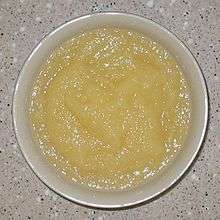BRAT diet



The BRAT diet is a diet that has been recommended for people with vomiting, diarrhea or gastroenteritis. Evidence, however, does not support a benefit.[1] It is no longer generally recommended as it is unnecessarily restrictive.[1][2]
An acronym, BRAT is a mnemonic for bananas, rice, apple sauce, and toast, the staples of the diet.[1] It is recommended that all people, regardless of age, drink plenty of fluids to prevent dehydration, along with oral rehydration solutions to replace the depleted electrolytes to avoid salt imbalance.[3] Severe, untreated salt imbalance can result in "extreme weakness, confusion, coma, or death."[4] The diet was first discussed in 1926.[1]
Nutritional analysis
The BRAT diet is no longer generally recommended.[2] The American Academy of Pediatrics states that most children should continue a normal, age appropriate diet. The foods from the BRAT diet may be added, but should not replace normal, tolerated foods. Sugary drinks and carbonated beverages should be avoided.[5] The BRAT diet is no longer routinely recommended by nutritionists at the Seattle Cancer Care Alliance (SCCA) to patients who have had stem cell transplants and have diarrhea due to Graft-versus-host disease as long-term use can lead to nutritional deficiencies. Cultured foods, rice water, coconut water and soluble fiber foods/supplements are more effective at treating ongoing diarrhea in conjunction with tolerated foods and beverages.
Adding rice, bananas, or pectin to the diet during diarrhea may be beneficial, but Duro and Duggan point out that the BRAT diet is not nutritionally complete and may be deficient in energy, fat, protein, fiber, vitamin A, vitamin B12, and calcium. Duro and Duggan also say that food restriction does not benefit diarrhea and actually causes individuals to suffer from diarrhea for longer periods of time, based on randomized clinical trials.[6]
Medical attention is required when on the BRAT diet if there is any blood or mucus present in the diarrhea, if the diarrhea is severe or if it lasts longer than 3 days.[7]
Alternatives
Additionally, other medical professionals advise first aid treatment for gastroenteritis by briefly limiting the diet to bland, easy-to-digest foods and plenty of liquids (including oral rehydration therapy, e.g. oral pediatric electrolyte solutions sold at retail).[8]
References
- 1 2 3 4 Mackell, S (1 December 2005). "Traveler's diarrhea in the pediatric population: etiology and impact.". Clinical Infectious Diseases. 41 Suppl 8: S547–52. doi:10.1086/432950. PMID 16267717.
- 1 2 King CK, Glass R, Bresee JS, Duggan C (November 2003). "Managing acute gastroenteritis among children: oral rehydration, maintenance, and nutritional therapy". MMWR Recomm Rep. 52 (RR-16): 1–16. PMID 14627948.
- ↑ Duggan, C; Santosham, M; Glass, RI (16 October 1992). "The management of acute diarrhea in children: oral rehydration, maintenance, and nutritional therapy. Centers for Disease Control and Prevention.". MMWR. Recommendations and reports : Morbidity and mortality weekly report. Recommendations and reports / Centers for Disease Control. 41 (RR-16): 1–20. PMID 1435668.
- ↑ Eileen McLaughlin, RN (July 24, 2000). "salt imbalance". Archived from the original on 2 July 2007. Retrieved 8 April 2007.
- ↑ Essentials of pediatric nursing. p. 685. ISBN 0-7817-5115-2.
- ↑ Duro, Debora; Duggan, Christopher (June 2007). "The BRAT Diet for Acute Diarrhea in Children: Should It Be Used?" (PDF). Practical Gastroenterology. Retrieved 2009-10-25.
- ↑ University Of Michigan Mott Children's Hospital. "BRAT diet: What is the BRAT diet?". Archived from the original on 20 February 2007. Retrieved 8 April 2007.
- ↑ Mayo Clinic Staff. "Gastroenteritis: First aid - Mayoclinic.com". Retrieved 6 March 2011.